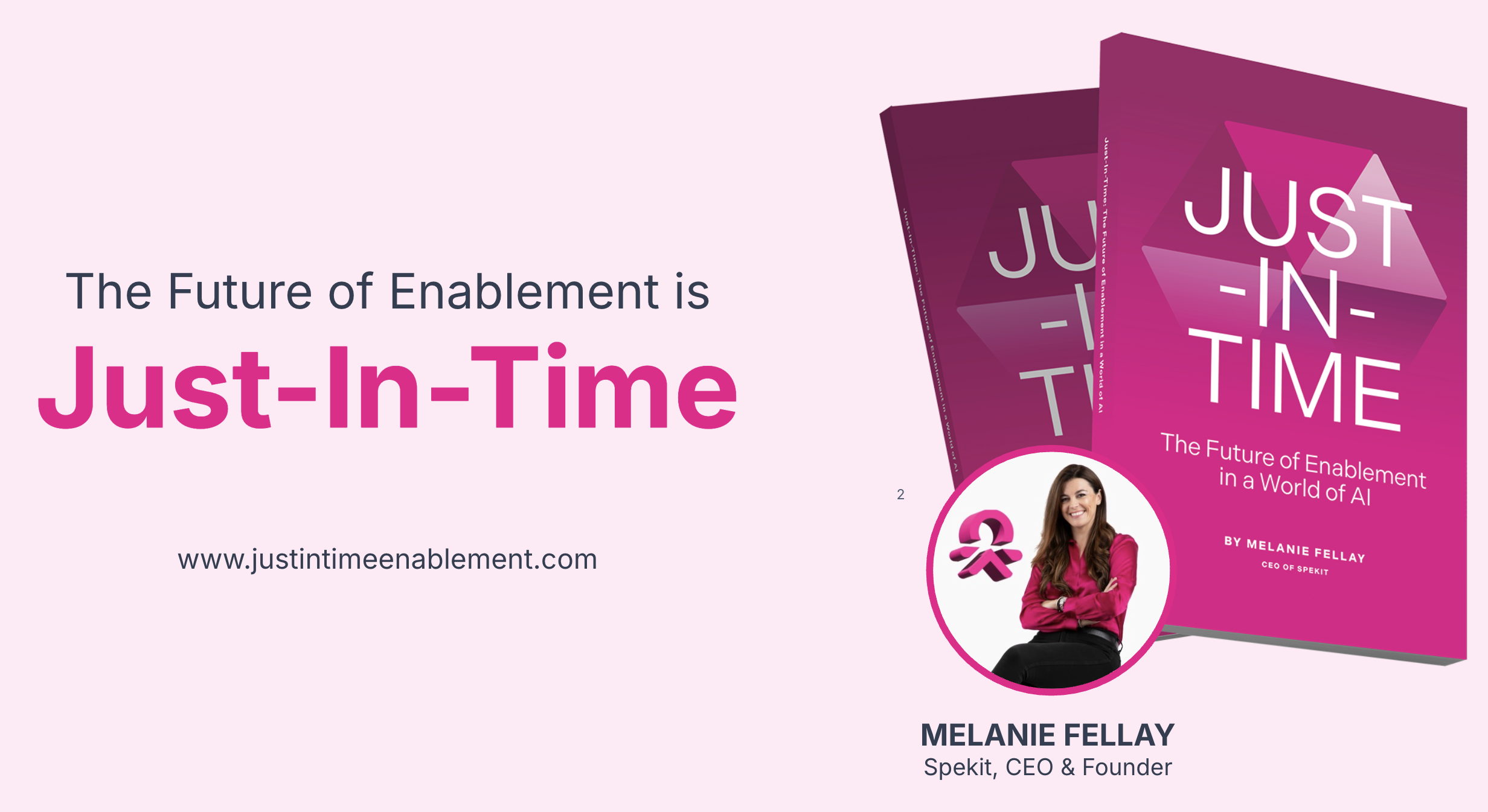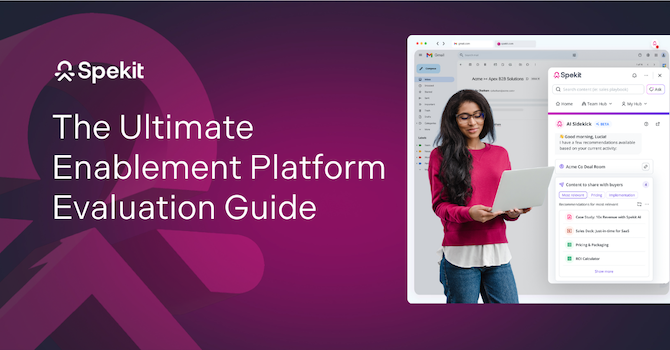Here’s the truth about enablement in 2025. Knowledge without context rarely changes behavior.
As Spekit CEO and Founder, Melanie Fellay, writes in her book Just-in-Time: Enablement in a World of AI, “Your reps aren’t lazy, they’re busy. Reps expect a consumer-grade experience.”
The best sales enablement platforms will respect that reality. They deliver the right nudge at the right time, inside the tools reps already use.
Not once at onboarding, but every day, in motion. The real gap isn’t volume of training or content. It’s access and application in the flow of work.
Modern sales enablement is contextual, personalized, simplified, unified, dynamic, and measurable. Here's what we mean by that:
Contextual: Guidance should adjust to the stage, account, and activity. If a rep is updating a Salesforce opportunity, they should see the two plays that matter for that stage and buyer, not a library. If they're drafting a follow-up, they should get the proof points and examples that fit the persona in front of them. Context trims cognitive load and increases action.
Personalized: One-size-fits-all is slow and forgettable. High performers need different coaching than new hires. A rep in healthcare needs different language than a rep in fintech. Personalization uses signals from CRM, calls, email, and past performance to recommend what will help this rep win this deal today.
Simplified: Fewer clicks. Fewer tabs. Fewer places to look. Content, coaching, and workflows belong in one experience that feels obvious to navigate. When the path to the answer is clear, adoption follows. When adoption follows, behavior changes.
Unified: Content lives once, not in six versions across six tools. Updates propagate everywhere. That single source of truth creates trust, saves time, and prevents the painful “which deck is current” dance that kills momentum.
Dynamic: Products, competitors, and messaging change weekly. Your system should change with them. Real-time nudges, everboarding playlists, and fresh talk tracks keep reps confident through constant change. Static playbooks cannot keep up.
Measurable: If you cannot see which content shows up in winning deals, you are guessing. Tie enablement to pipeline and revenue. Double down on what moves the needle. Stop what doesn’t. Simple.
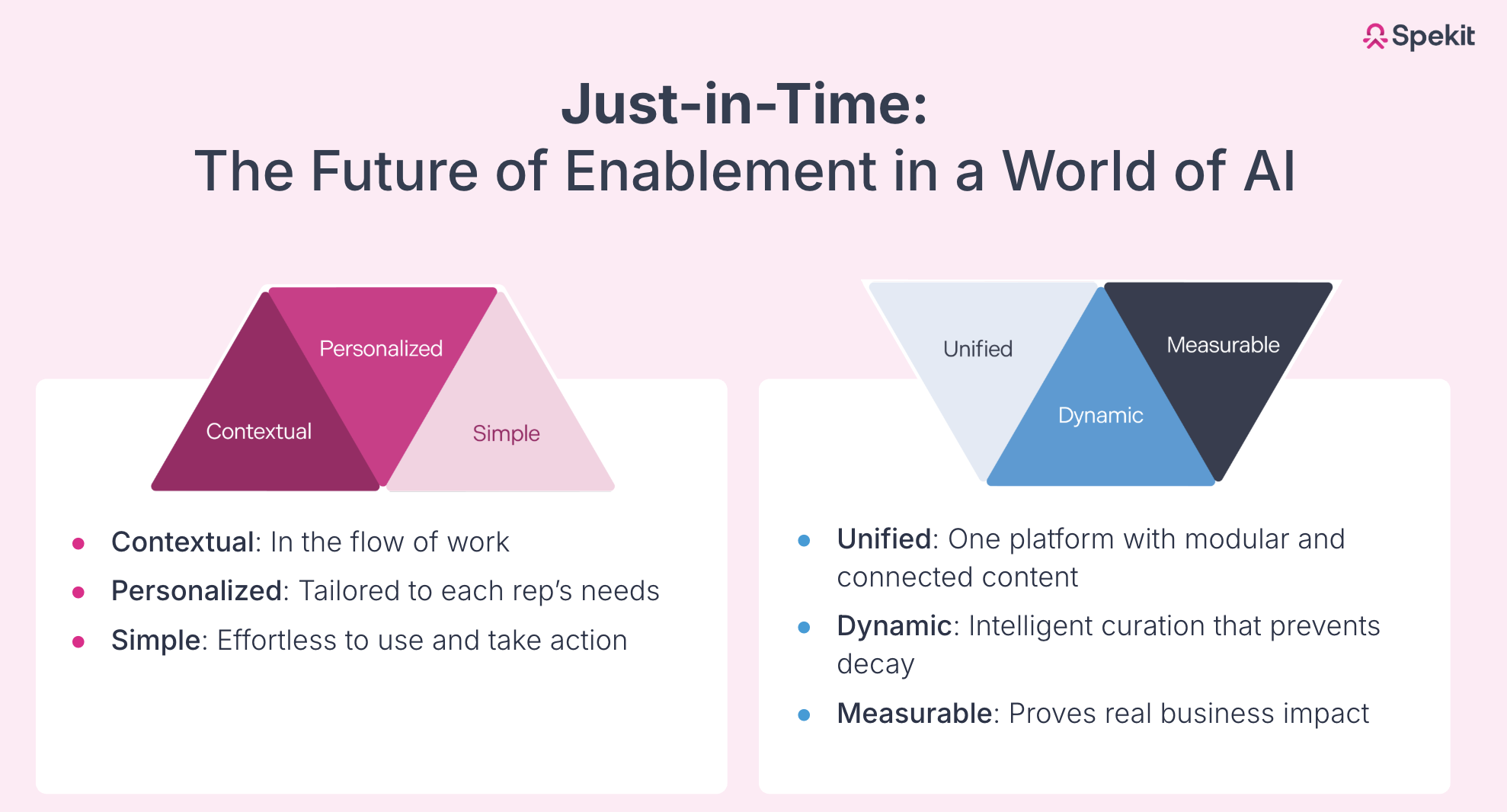
Not every sales enablement platform in this guide reinforces training the same way. Some simulate conversations, others surface content in the CRM but only through tedious tagging, others guide outreach from buyer activity. What unites the strongest tools is this set of principles: contextual, personalized, simplified, unified, dynamic, measurable. Build around these and you turn enablement from a library into a system of action.
What is sales enablement software?
Sales enablement software is a tech platform that provides sales reps with the necessary resources, training, and coaching to improve their performance and close more deals.
Unfortunately, many sales enablement tools today do less enabling and more knowledge dumping. Reps get access to tons of information stored within a content repository but it's difficult to find, quickly access, reference, and keep updated.
Sales enablement software should be different. A good platform should deliver the right knowledge, tools, and guidance exactly when reps need it — whether they’re prepping for a big meeting, handling a tough objection, or trying to move a deal across the finish line.
Common features of sales enablement tools include:
- Content management: They offer a centralized library where reps can access updated playbooks, case studies, presentations, and other materials to share with prospects.
- Coaching and training: They give sales reps access to training modules, sales playbooks, and templates to help them develop their skills.
- CRM integration: B2B sales enablement tools often sync with CRMs like HubSpot and Salesforce so that reps can manage customer information and access sales materials without switching between multiple tools.
- Sales analytics: They track how buyers engage with content and how reps perform against key metrics. These insights help sales teams identify what’s working, spot gaps, and continuously optimize sales strategies.
- Bonus: AI-driven features: Most will promise some type of AI-functionality to help with locating content or structuring your content effectively. More modern sales enablement platforms like Spekit use AI to proactively recommend content, surface relevant training based on rep activity, and analyze sales calls for coaching insights. What people call a bonus should really be a fundamental feature.
Benefits of a sales enablement software
Here’s how sales enablement tools can make a difference for your team:
1. Faster, more consistent onboarding
A good sales enablement platform streamlines the messy, ad-hoc onboarding experience many sales teams struggle with. Instead of overloading new reps with information, they get structured, bite-sized training tied to real sales tasks. This shortens ramp time and ensures every new hire builds the same foundation, no matter who’s training them.
2. Easier access to the right content
Instead of digging through endless emails or Slack threads, reps get the right content delivered at the right time. This helps reps stay consistent, reduces mistakes, and makes sharing updated, approved content with prospects easy.
3. Smarter, data-driven coaching
Tools with conversation intelligence and performance tracking give sales managers visibility into rep behavior. Instead of guessing who needs help (and with what), leaders can coach based on real conversations, actions, and outcomes.
4. Higher rep productivity
When reps spend less time searching for information or second-guessing the next step, they sell more. Sales enablement software removes friction, supports reps at every stage, and builds their confidence, all of which leads to more closed deals and a stronger sales culture.
5. Stronger alignment between sales and marketing
The best sales enablement tools create a feedback loop between sales and marketing teams. Reps can flag which content resonates and what falls flat, giving marketing the data they need to build better assets. This closes the gap between what’s created and what actually drives deals forward.
Top picks overview: The best modern sales enablement software for B2B
We picked each tool in our "sales enablement software stack" from a range of use cases and categories that all help a modern sales enablement team.
Each tool in this stack plays a distinct role in reinforcing training, enabling reps, and supporting buyers without bloating your workflow.
The 9 best sales enablement software and tools (in-depth review)
Here are the top sales enablement platforms across key categories:
1. Spekit: Just-in-time sales enablement software
Spekit is the modern AI-powered enablement platform that unifies content management, enablement, and personalized guidance to help revenue teams automate workflows and close deals quicker. Spekit combines an intelligent content management platform with AI Sidekick, the just-in-time sales assistant™ that leverages signals from CRM, call intelligence, and communication tools to deliver personalized guidance, content, and recommendations directly to reps right within their flow of work.
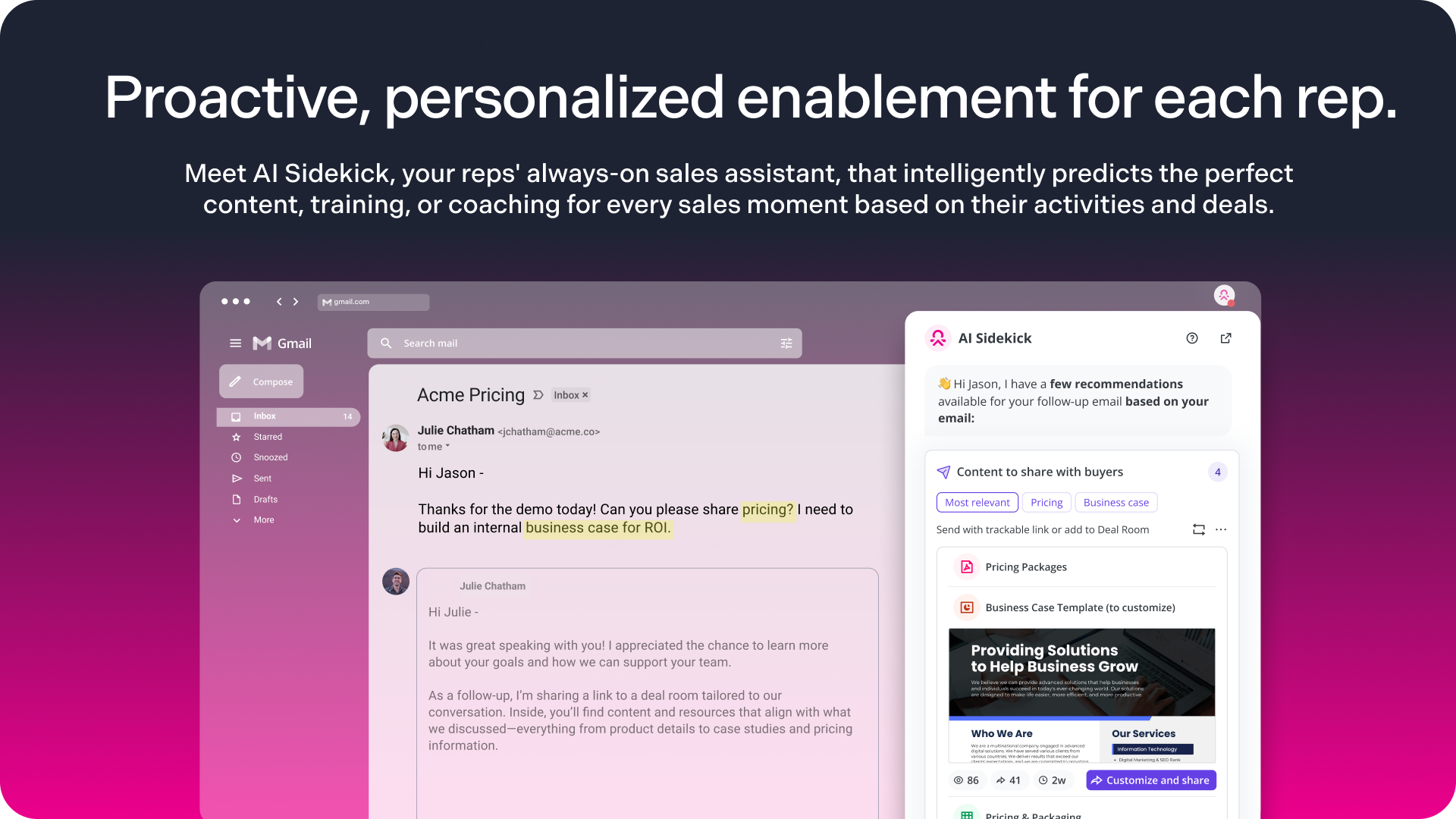
Sidekick embeds contextual AI agents into a rep’s daily tasks to anticipate needs and automate workflows like curating and creating content, or building Deal Rooms. By surfacing personalized guidance and resources directly in their flow of work, Sidekick enables reps to prepare for calls, follow up, and launch custom Deal Rooms in seconds
Granular analytics on content consumption and buyer engagement show sales leaders which initiatives move deals forward, what content directly impacts pipeline, and where performance breaks down. By combining these insights with AI-driven guidance, Spekit strengthens change management to drive stronger adoption and accelerate execution at scale.
Key features of Spekit:
- Sales content management system: Spekit is an advanced AI-powered sales content management system. Unify sales and marketing content in a single source of truth. Create content, upload assets, or sync from Google Drive, SharePoint, or Confluence. AI detects duplicates, flags outdated assets, and recommends the most relevant resources. Governance and user-level analytics keep content accurate and consistent.
- AI Sidekick: The only AI-powered just-in-time enablement assistant™ that leverages signals from CRM, call intelligence, and communication tools to deliver personalized guidance, content, and recommendations directly to reps. Sidekick agents automate content curation and creation, support change management, and orchestrate task completion with embedded tooltips.
- Deal Rooms: Centralized, branded buyer hubs that reps create and update in the flow of work with AI Sidekick. Share a single, trackable link. Changes sync immediately. Reps get real-time notifications on views and time on page, while admins see buyer engagement analytics tied to pipeline and revenue impact.
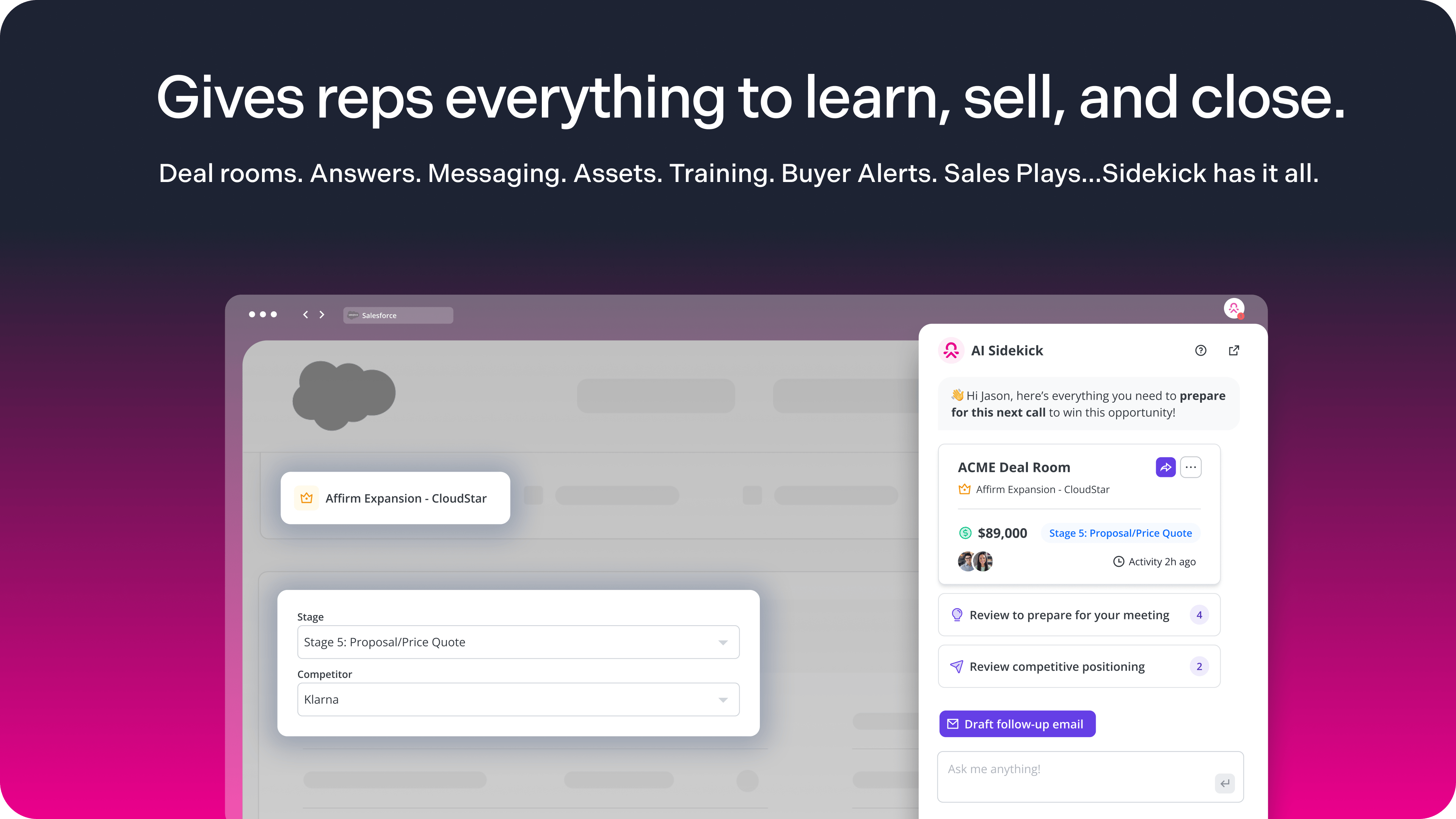
- Revenue Insights and Analytics: Connect enablement to revenue with dashboards that show influenced pipeline, influenced revenue won, and the content that drives impact. Monitor Deal Rooms created and those tied to closed-won.
- Governance Dashboards: Automated oversight flags outdated or low-adoption assets, high-priority reviews, and missing expert contributions. Manage version control, permissions, and access by team or role so only approved content reaches reps and buyers.
- Just-in-time knowledge and content delivery: Surface answers in Salesforce, HubSpot, Gmail, Outlook, Gong, LinkedIn, and Chrome through a lightweight extension. No heavy mappings.
- In-app alerts and microlearning: Targeted alerts and quick knowledge checks reinforce changes without pulling reps from work.
Best for: Spekit is best for growing teams of 20 to 500+ reps at mid to enterprise companies that want to turn real-time knowledge access into a competitive advantage their reps can leverage to learn, grow, and sell at the speed of business.
💡 Spekit acts as the connective tissue of your sales enablement stack. See how Spekit helps teams like yours spend 90% less time searching for answers.
Notable alternatives:
Highspot
- Robust content management and buyer engagement with extensive tagging and digital sales rooms.
- Considerations: Portal-centric, which means extensive tab switching. Teams report higher admin effort to keep taxonomies fresh and prevent content decay. In-the-moment guidance across CRM and email requires additional configuration or workflow
Seismic
- Enterprise-grade content lifecycle, localization, and governance. Suits complex compliance needs and large catalogs.
- Considerations: heavy implementation and ongoing administration. Better for structured content delivery and formal training.
Showpad
- Combines CMS with training and certifications to align marketing and sales. Intuitive content experiences and basic coaching.
- Considerations: Content is accessed through the Showpad app or extension. Difficult to update, manage, and maintain up-to-date content. Doesn't surface contextually in the flow of work.
Real customer quote:
"This morning I found three assets, generated the links, and had the email out within 2 minutes start to finish. This would’ve taken me a good 20 minutes in a previous sales content management platform and a high likelihood that I would’ve grabbed the wrong asset” - Anthony Panvini, Director Enterprise New Logos | InMoment
2. Gong: Conversation intelligence for targeted coaching
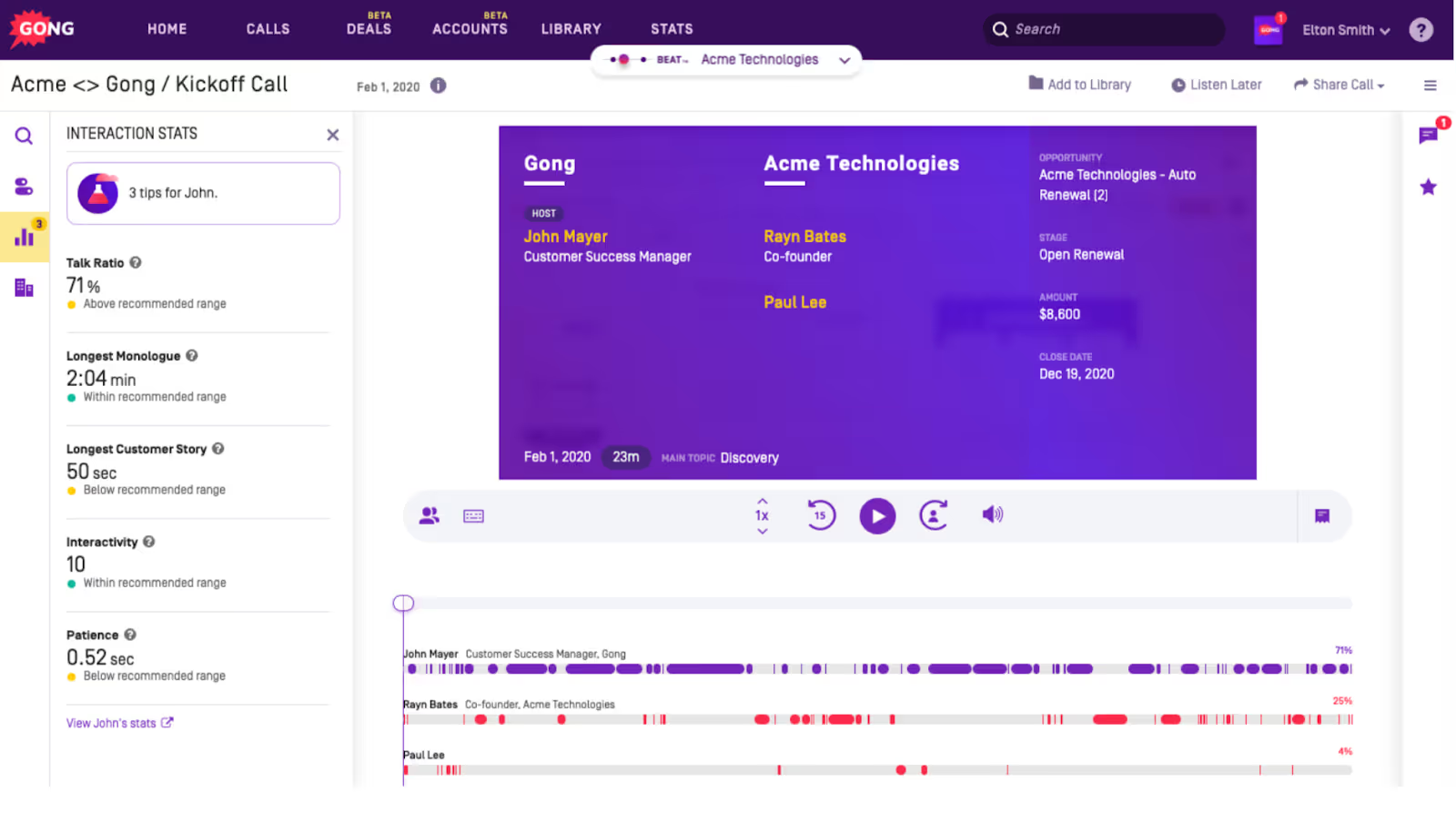
Gong is a revenue AI platform that gives sales leaders and managers visibility into what’s happening on calls, demos, and meetings.
Instead of relying on secondhand updates or gut feelings, Gong records and analyzes every interaction, flagging risks, tracking key moments, and highlighting where deals or reps might need attention.
For example, sales leaders can open Gong and instantly see which deals are at risk, which reps are dominating calls instead of asking questions, or who’s struggling to handle a common competitor objection. This way, they know exactly who to coach, when to intervene, and how to replicate top-performer behaviors.
Key features:
- AI transcription and call scoring: Automatically transcribes calls and evaluates them for best practices, saving hours of manual review time.
- Deal risk alerts: Flags deals showing warning signs—like no next steps, weak engagement, or missed follow-ups—so managers can step in before it’s too late.
- Talk ratio and topic tracking: Analyzes who’s talking too much, who’s listening, and what key topics (like pricing or contract terms) are actually being discussed.
- Competitor and objection theme tracking: Surfaces trends in competitor mentions or objections across calls, helping sales and product teams stay proactive.
- Coaching scorecards: Lets sales managers give structured, targeted feedback based on real call performance, turning subjective coaching into a repeatable system.
Best for: Mid-market and enterprise sales teams handling large pipelines or high call volumes, especially where frontline managers are stretched thin and need data to coach effectively at scale.
💡 If you already use Spekit, you can instantly reinforce insights from your knowledge base in Gong. For instance, if your rep is battling a common pricing objection on a Gong call, Spekit can surface a quick one-liner rebuttal or cheat sheet in real-time helping reps course-correct while they sell.
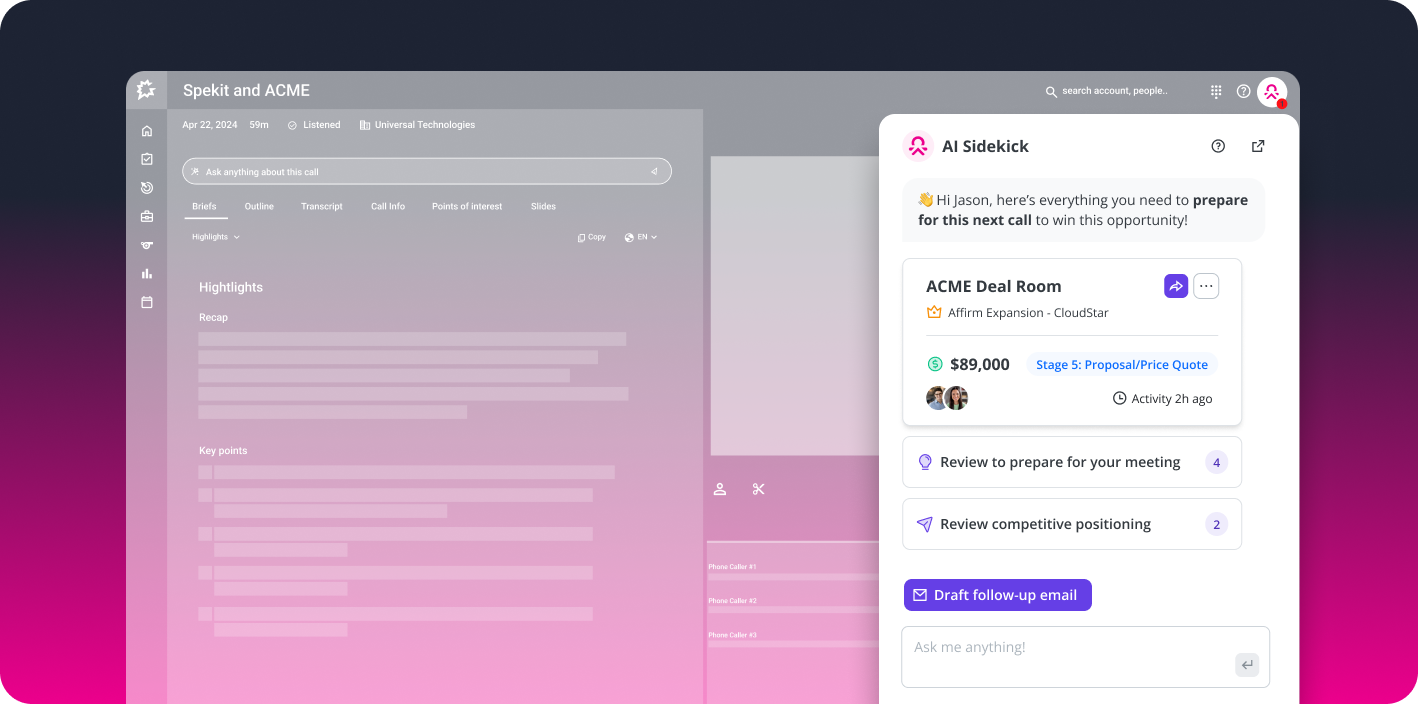
Notable alternatives:
- Chorus (ZoomInfo): Offers strong conversation intelligence features, though some users note heavier workflows compared to Gong.
- Clari Copilot: Good lighter-weight option for real-time call analysis, particularly for smaller teams.
- Avoma: Excellent for automated meeting notes and broader cross-functional use, though less focused purely on sales calls.
Real customer quote:
"Gong insights help us learn, train our reps, and — most importantly — provide a better service to our customers and prospects. Working with Gong gives me confidence that we will succeed.” - Paul Santarelli, Chief Sales Officer | PitchBook
3. Navattic: Unique buyer engagement via interactive product demos
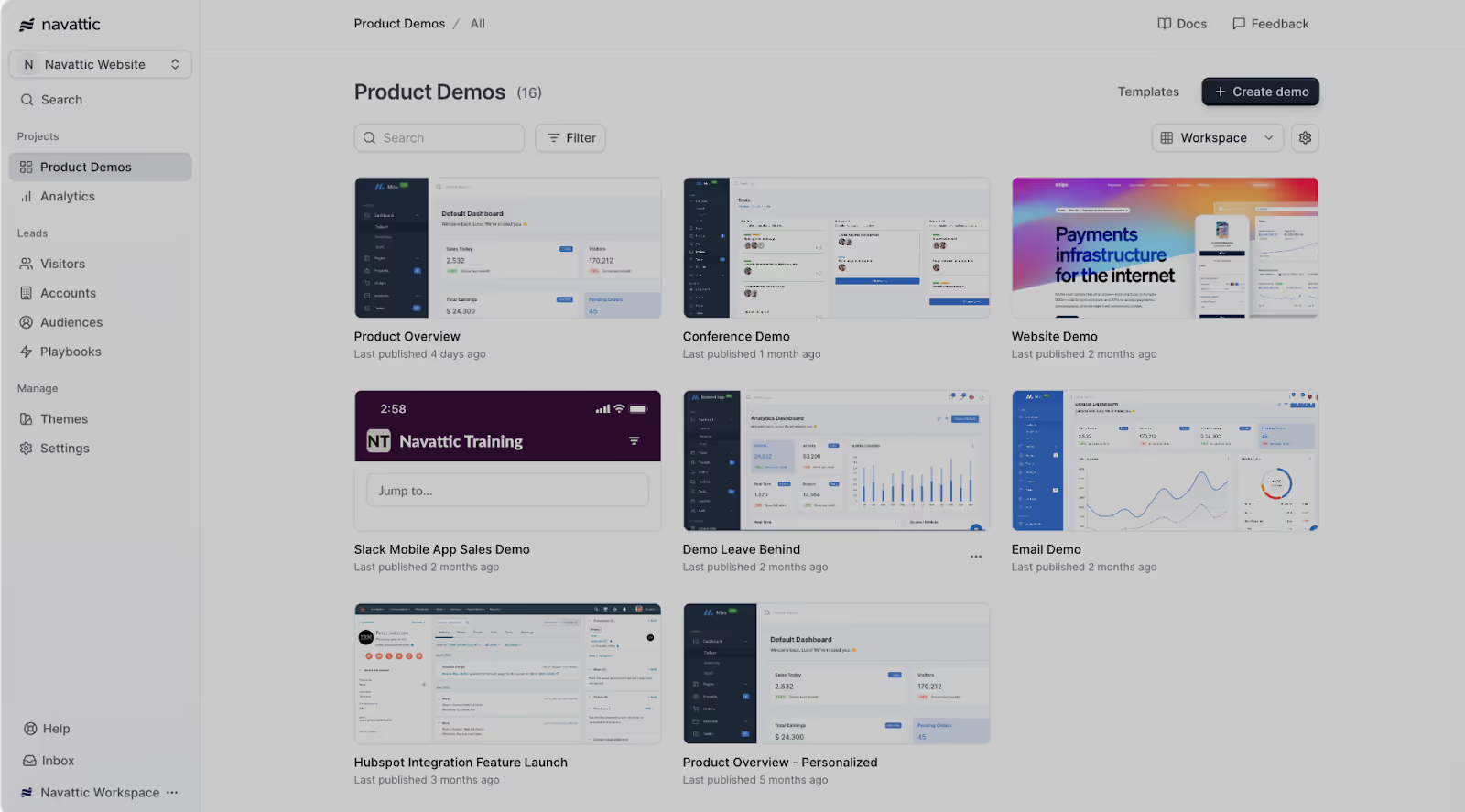
Navattic helps companies create interactive, click-through product demos—no engineers or custom building needed.
Instead of requiring prospects to book a meeting just to see the product, Navattic allows them to watch a product demo first. This helps sales and marketing teams capture interest earlier, qualify buyers faster, and personalize follow-ups based on what the prospect actually explored.
For instance, if a prospect clicks on a Navattic interactive demo and spends the most time on a specific feature set, Navattic alerts reps about it. A rep can then follow up with a targeted case study about that feature set, making outreach smarter and way more effective.
Key features:
- No-code product tour builder: Build interactive product experiences without needing coding knowledge.
- Engagement analytics: Track how long prospects interact with demos, what steps they click on, and where they drop off.
- Demo templates by persona/use case: Quickly customize demos based on industry, role, or specific pain points, to increase relevance and engagement.
- CRM and marketing automation platform (MAP) integrations: Sync demo engagement data with your CRM or marketing platforms to trigger smarter workflows.
- Lead attribution from demo views: Connect demo activity back to lead records, helping teams understand which demo experiences drive pipeline.
Best for: SaaS, product-led growth (PLG), or consultative sales teams that want to scale buyer interest without scheduling more live demos or relying on heavy technical resources.
💡Spekit makes it easier for reps to act on Navattic demo insights. Teams can embed follow-up strategies, demo personalization tips, and next-step guidance directly into Salesforce, so reps always know how to tailor their outreach based on what prospects actually explored.
Notable alternatives:
- Reprise: Supports backend sandbox environments, but requires technical knowledge.
- Tourial: Strong top-of-funnel tool for marketing teams.
- Consensus: For enterprise-level stakeholder collaboration and demo personalization for large buying groups.
Real customer quote:
"Our Navattic demos have generated 1000s of high-intent leads that are entering our sales cycle already familiar with our product and key use cases.” - Insider
4. Dock
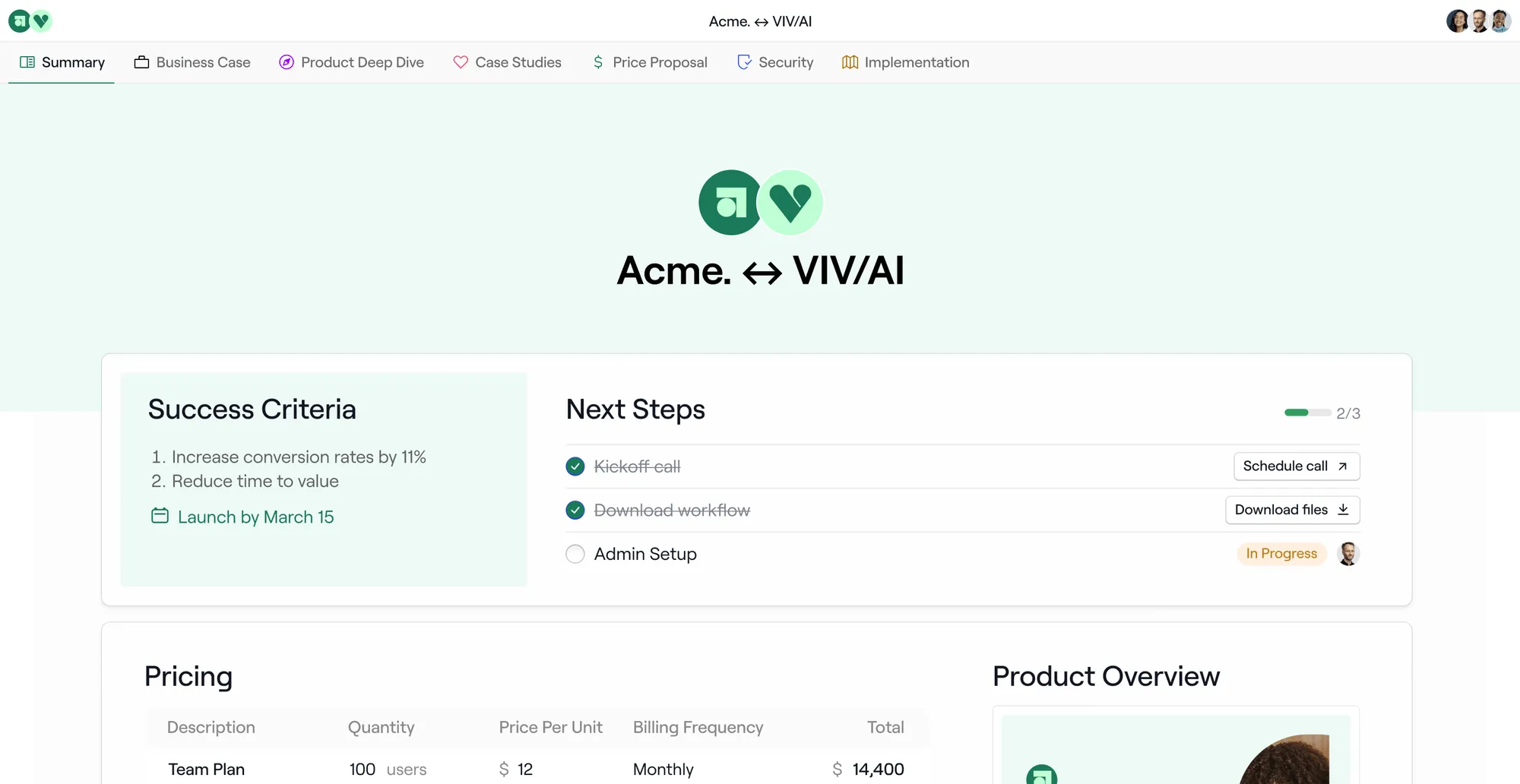
Dock is an AI revenue enablement platform that replaces static training with real-time guidance for sales teams and buyers. Instead of dumping content into folders that go unused, Dock creates collaborative workspaces that guide customers from intro call to onboarding to renewal in one seamless link.
AI automatically organizes your content library, generates personalized business cases and meeting summaries instantly using live CRM data and call transcripts, and provides real-time answers through an AI Enablement Agent when reps need them most. Sales deal rooms help teams standardize follow-up, enable buyer champions to sell internally, and track engagement analytics to improve forecasting accuracy.
Key features:
- AI-powered deal rooms: Centralize sales content, AI-generated documents, quotes, and mutual action plans in one shareable workspace that increases close rates and shortens sales cycles
- AI Documents: Generate personalized business cases, executive summaries, and action plans in seconds using live CRM data and call transcripts
- Content management: Automated tagging, AI search, and performance analytics help teams find the right assets quickly and track what actually drives revenue
- AI Enablement Agent: Provides real-time answers and guidance based on your CRM and Dock data
- Learning Playbooks: Dock workspaces repurposed for internal training
- Connected workspaces: Seamlessly transition the same workspace from sales to onboarding to renewal, eliminating messy handoffs between teams
Best for: Mid-market and high-growth revenue teams where Sales, Customer Success, and Marketing need to operate from the same playbook. Dock is especially valuable for organizations managing complex, multi-stakeholder deals, scaling consistent processes across the customer lifecycle, or looking to enable cross-functional collaboration without adding heavyweight enterprise platforms.
Notable alternatives:
- Spekit: Excellent for just-in-time enablement and content delivery directly inside workflows like Salesforce and Slack, though focused more on rep-side guidance than buyer collaboration
- Seismic: Comprehensive enterprise enablement platform with strong content management, but built on legacy architecture without AI-native capabilities
- Highspot: Robust sales enablement suite with good analytics, though can feel heavyweight for teams that need faster implementation and modern AI-powered features
Real customer quote:
"If I had a prospect go over 12 views on my Dock, they had like a 97% chance of closing. The level of Dock activity was better forecasting than being a green light in HubSpot." - VP of Sales | Nectar
5. Second Nature: Peer learning and sales roleplay
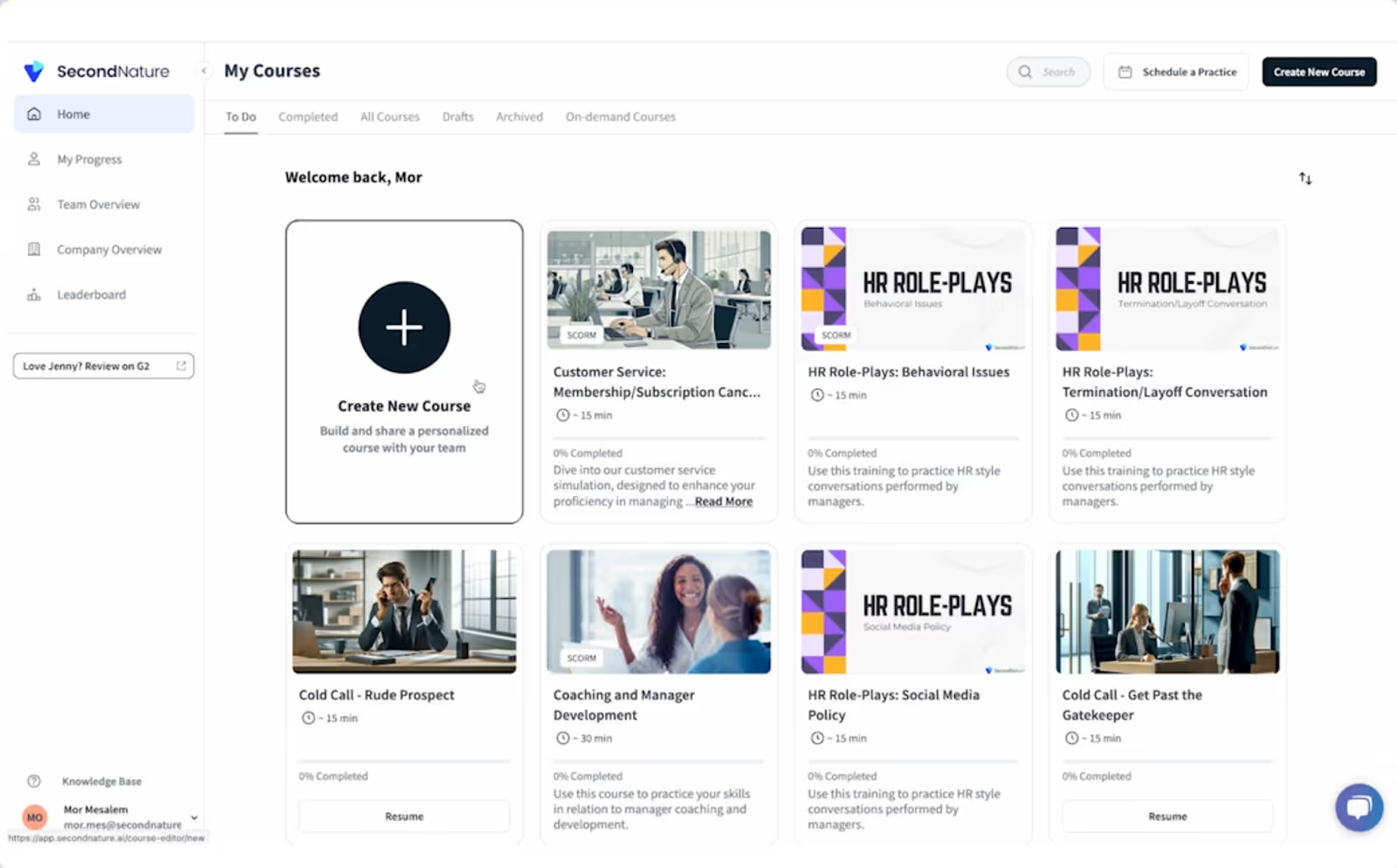
Second Nature is a sales training platform that uses AI avatars to simulate real buyer conversations. It gives reps a safe, structured way to practice objection handling, discovery, and messaging delivery.
Instead of relying solely on expensive in-person role plays or inconsistent peer feedback, reps can practice anytime, get immediate scoring, and continuously improve their sales performance before going live with customers.
For example, before a major product launch, sales leadership could require reps to pass a mock conversation with an AI CFO inside Second Nature. The platform would automatically grade each rep’s tone, content, and clarity, and only those who meet certification standards can pitch the new messaging live. This ensures that reps are truly ready, not just "trained."
Key features:
- AI-based roleplay partners: Provide realistic buyer simulations 24/7, allowing reps to practice in a low-pressure, scalable environment.
- Pitch scoring and coaching feedback: Automatically grade reps based on tone, key messaging points, and conversation flow, giving immediate, actionable feedback.
- Customizable scenario libraries: Build and customize a wide range of scenarios, like discovery calls, objection handling, or negotiation practice, to match real-world situations.
- Manager review dashboards: Enable managers to review scores, track progress, and prioritize coaching based on actual practice data.
- LMS and CRM integrations: Sync certifications and practice results into learning systems or CRMs to keep rep records updated without extra administrative work.
Best for: Enablement teams supporting global sales reps, or companies that are launching new products, entering new markets, or onboarding at scale.
💡Spekit reinforces what reps learn inside Second Nature by embedding objection handling tips, certified pitch templates, and key messaging directly into Gmail, Outreach, or wherever objection is happening. Once reps pass certification, Spekit keeps those talking points easily accessible during real conversations.
Notable alternatives:
- Allego: Strong for video-based coaching and practice, but lacks AI-driven conversation simulations.
- Saleshood: Great for asynchronous peer feedback and recording exercises, but doesn’t simulate live buyer interactions.
- Seismic Learning: Includes basic practice exercises, but doesn’t offer realistic AI conversation simulations.
Real customer quote:
"Prior to [working at] Zoom, I’ve never seen a program adopted and embraced as successfully as the Jenny.ai program, which Second Nature helped us build.” - Mike Fisher, Sales Enablement Manager | Zoom
6. Guru: Knowledge management
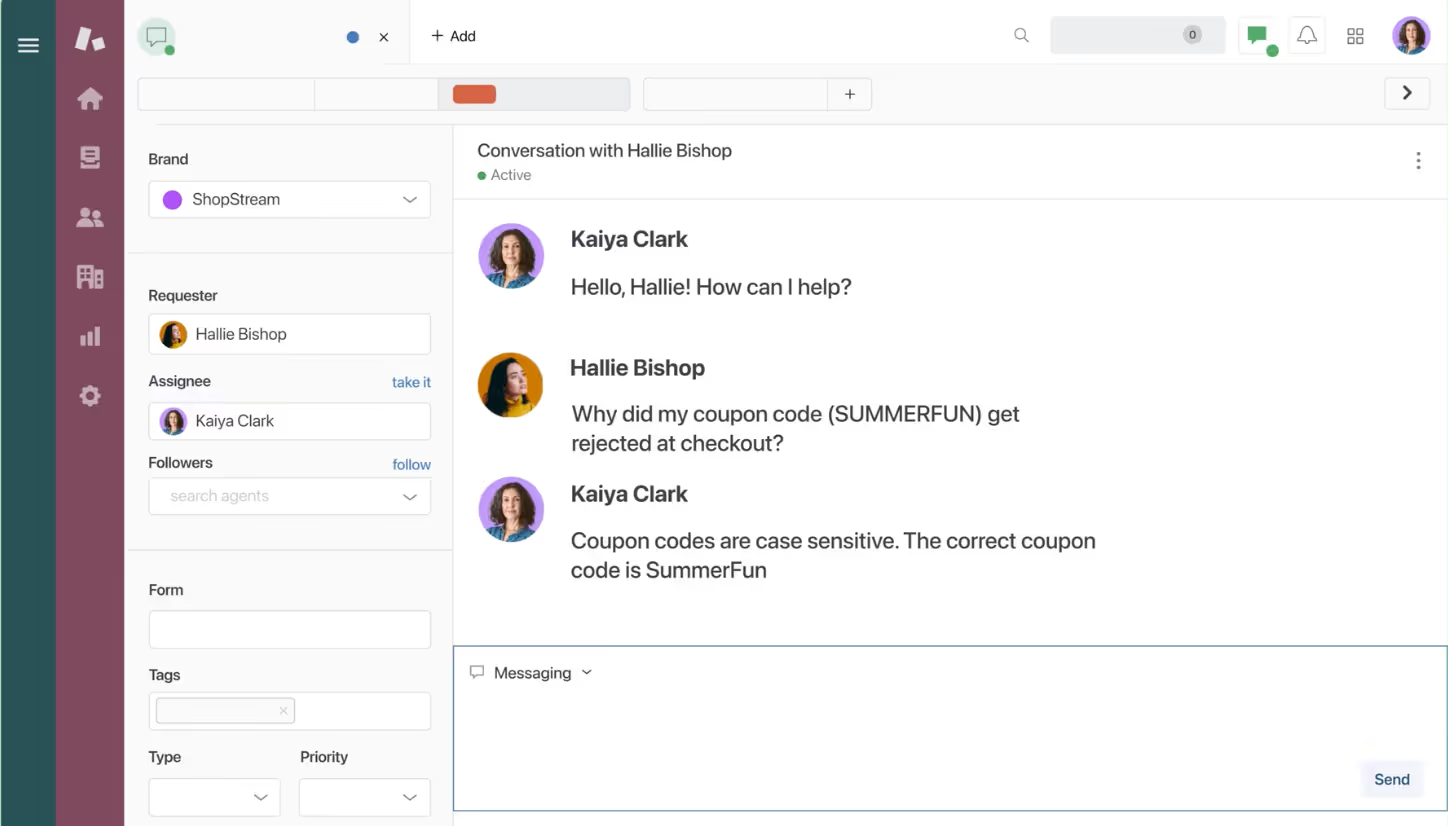
Guru is an AI-powered platform that acts as a centralized, searchable brain for sales, support, and operations teams. Instead of pinging sales leaders or searching through old email threads, teams can quickly find verified, up-to-date answers right where they work, whether that’s in Chrome, Slack, Microsoft Teams, or elsewhere.
Guru is especially powerful for managing evergreen information that reps and internal teams need to reference often, like pricing policies, escalation procedures, or competitive intelligence. So, if a rep forgets the exact steps needed to escalate a contract approval, they can use the Guru Slack bot to pull up the most current escalation SOP instantly.
Key features:
- Browser extension: Quickly access and search for knowledge directly from any web page.
- Slack and Microsoft Teams integrations: Retrieve verified knowledge through chat tools, which makes it easy to access answers without leaving conversations.
- Verification workflows: Regularly validate and update knowledge cards to ensure content stays accurate and trustworthy over time.
- Knowledge alerts: Push important updates or changes directly to relevant teams so nobody misses critical information.
- Usage tracking: Monitor which knowledge cards are being used most (or not at all).
Best for: Cross-functional teams that share a high volume of internal information, or organizations that need a structured, scalable solution for internal documentation across departments.
💡 If you already use Spekit, it complements Guru by delivering action-ready snippets, key process steps, and reinforcement exactly when and where reps need to act—bridging the gap between static information and real-time execution. For example, Guru might store the entire discounting policy, while Spekit shows the exact snippet or checklist when a rep selects a discount in Salesforce. If you're choosing between the two, focus on your biggest friction point: if reps struggle to find and act on information at the right time, Spekit is often the more immediate unlock.
Notable alternatives:
- Confluence: Highly flexible for documentation, but not built for fast, in-workflow enablement.
- Notion: Extremely customizable, though it requires more manual setup and offers less structured governance for sales enablement needs.
- Tettra: Lightweight, Slack-first wiki that’s simple to set up, but can be limited for complex documentation needs.
Real customer quote:
"Guru has completely changed how we onboard. It’s no longer about dumping information on new hires. Instead, we’ve created an environment where they can confidently search, find, and apply knowledge—just like they would in a real support scenario.”– Katharine Dooley, Customer Support Manager | HireVue
7. Scribe: Process documentation
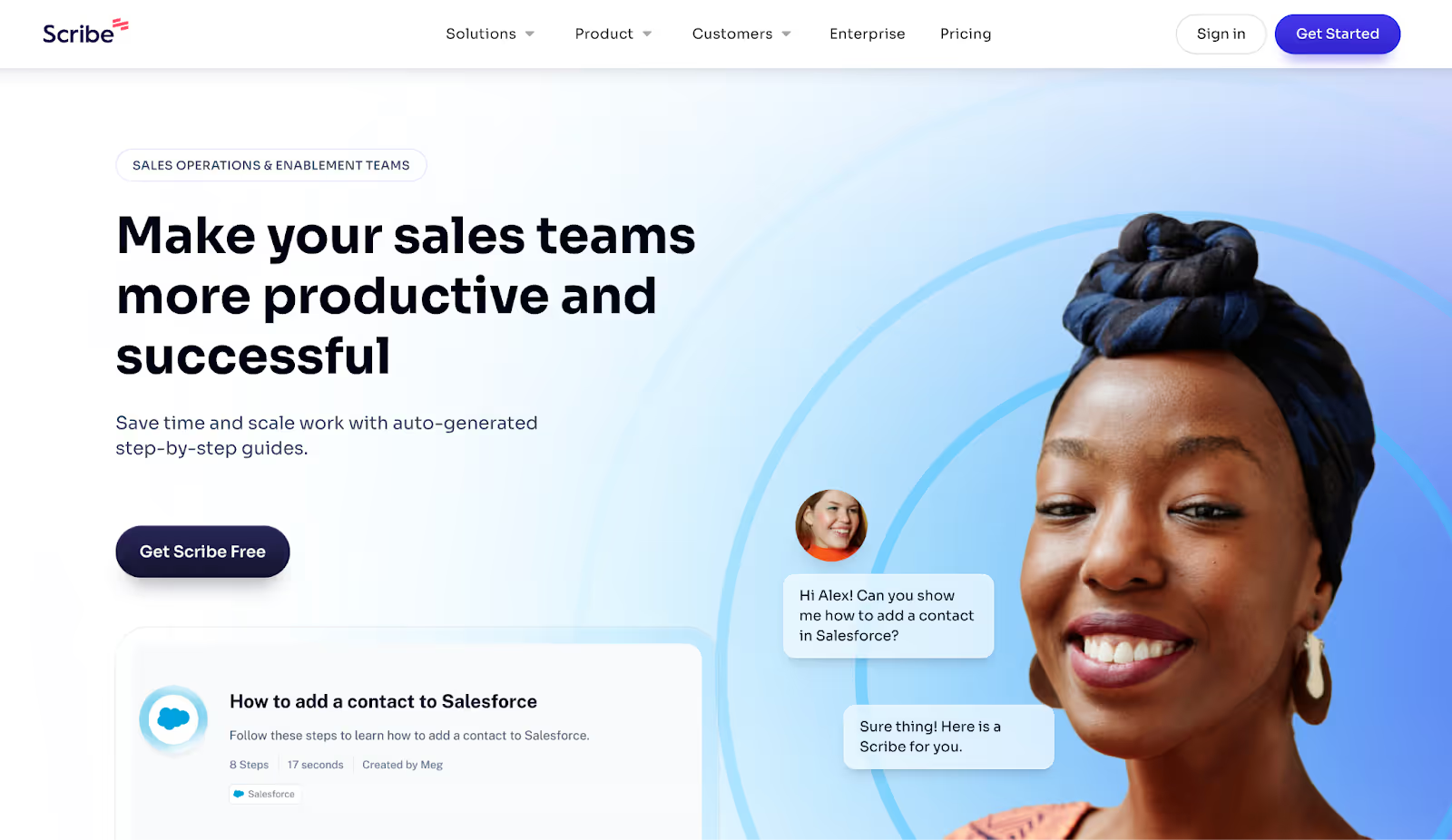
Scribe is a documentation tool that automatically generates visual, step-by-step guides from screen recordings. Instead of manually writing out instructions or taking endless screenshots, teams can create polished process documentation in minutes, saving hours of time.
For example, a sales operations lead could record themselves updating a lead record in Salesforce. As they click through the workflow, Scribe automatically captures each step, adds screenshots, and generates a clean guide. That guide can then be linked inside a Spekit card, making it instantly accessible to the sales team right where they work.
Key features:
- Auto-capture workflows: Record a task once and automatically generate a step-by-step guide without any manual formatting.
- Screenshots and editable steps: Automatically includes screenshots with the ability to edit text, highlight clicks, and adjust instructions as needed.
- Chrome extension: Capture processes directly from your browser with a simple click, making it easy to document CRM workflows, support tools, and more.
- Shareable links or embeds: Instantly share guides via links or embed them inside wikis, emails, or enablement tools like Spekit.
- Workspace permissions: Manage who can create, edit, and view guides to maintain control and governance over documentation.
Best for: Operations, enablement, and support teams that frequently need to document internal tools and systems for onboarding, training, handoffs, or change management.
💡Scribe captures the process once. Spekit ensures those processes are distributed contextually by surfacing critical workflows exactly where reps or employees need to apply them during their daily work.
Notable alternatives:
- Tango: Offers similar auto-capture functionality but tends to lean more toward individual, consumer-focused use cases.
- Loom: Great for recording videos but less efficient for creating structured, step-based written guides.
- Notion: Highly flexible, but documentation in Notion requires manual formatting and is harder to standardize across fast-moving teams.
Real customer quote:
"Since implementing Scribe’s SOP software, our team has been able to coordinate and document our processes with ease." - Zachary Lutterbie, Staff Business Analyst | Intuit
8. Clay: Prospect intelligence
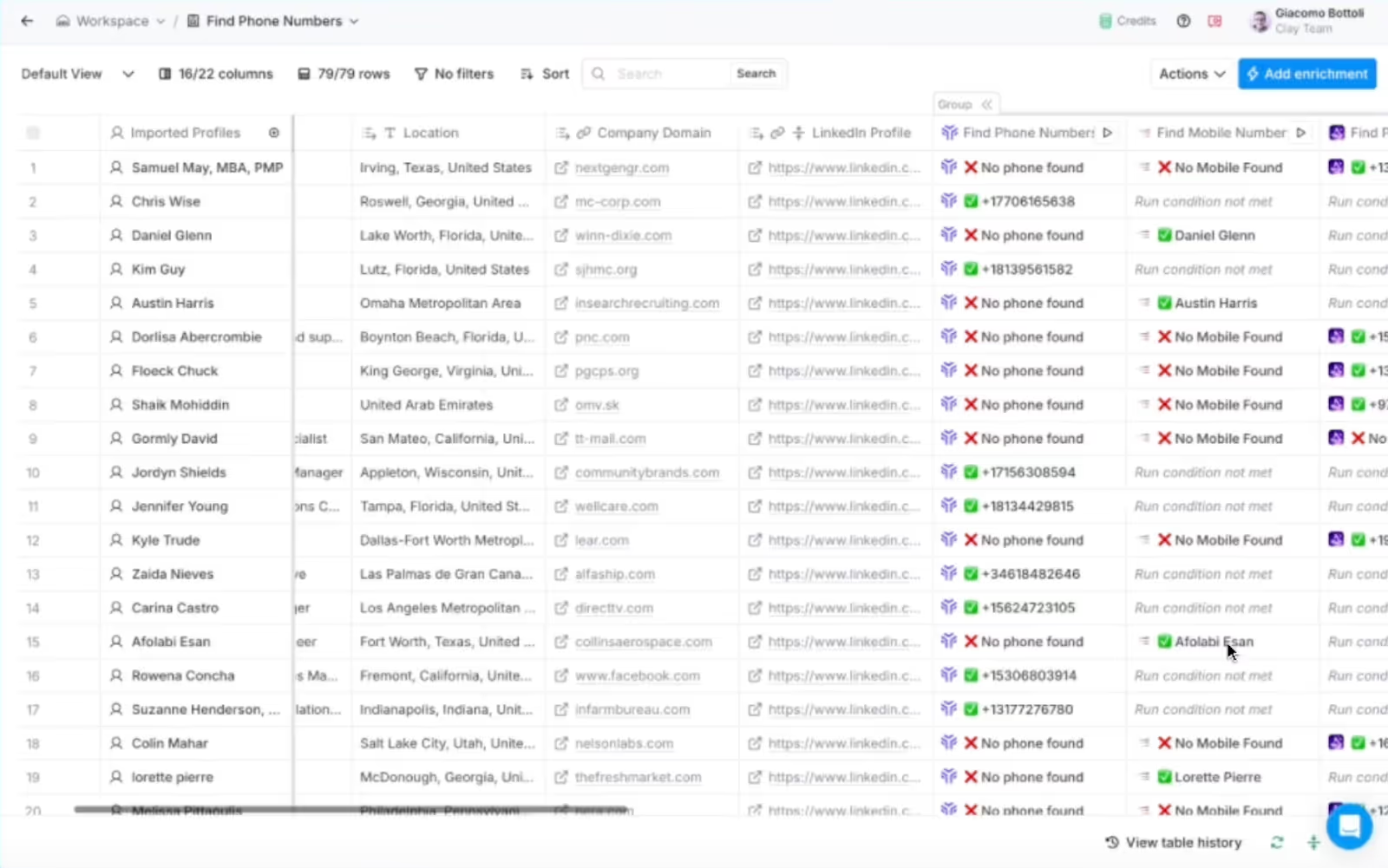
Clay is a prospecting and data enrichment platform that helps sales teams personalize outreach at scale without getting bogged down in manual research. Clay automatically pulls prospect data from over 50 sources (including LinkedIn, company news pages, and websites), detects key buying signals, and builds workflows that surface the right leads at the right time.
For example, SDRs can set up a workflow in Clay to find leads who recently changed roles. Clay enriches each profile with social media posts, job descriptions, and recent news, enabling the SDR to personalize outreach in just one click. Instead of researching every prospect manually, reps spend more time connecting and less time digging.
Key features:
- Multi-source enrichment: Automatically pulls and consolidates prospect data from over 50 different sources into a single view.
- Buying signal detection: Flags critical events like new hires, fundraising rounds, product launches, and other buying triggers, so reps can prioritize hot leads.
- Workflow logic: Automate lead filtering, enrichment, and scoring with flexible, no-code workflows tailored to your prospecting strategy.
- AI-assisted personalization: Generate dynamic, context-driven messaging suggestions based on enriched prospect data to speed up custom outreach.
- CRM and email integrations: Seamlessly push enriched leads and personalized messages into your CRM or sales engagement platforms for immediate action.
Best for: Outbound sales teams that need to balance high-volume outreach with high-context personalization.
💡 Clay helps reps find the “who” and “why” behind outreach. Spekit steps in to guide the “how” by surfacing messaging frameworks, persona-specific playbooks, and tailored value props inside the CRM as reps move from lead identification to engagement.
Notable alternatives:
- Apollo: Strong for building prospect lists and running outbound campaigns.
- ZoomInfo: A market leader for robust contact databases, though it’s less customizable.
- Cognism: Specializes in GDPR-compliant data enrichment, making it a strong choice for teams focused on European markets.
Real customer quote:
"Clay saves us hours a week that we previously spent researching and vetting companies that applied to our startup program. Our auto-approval rate has jumped to ~40% with no manual work needed.” - Josh Kim, Head of Growth Programs | Notion
9. Trumpet: Digital Sales Room (DSR)
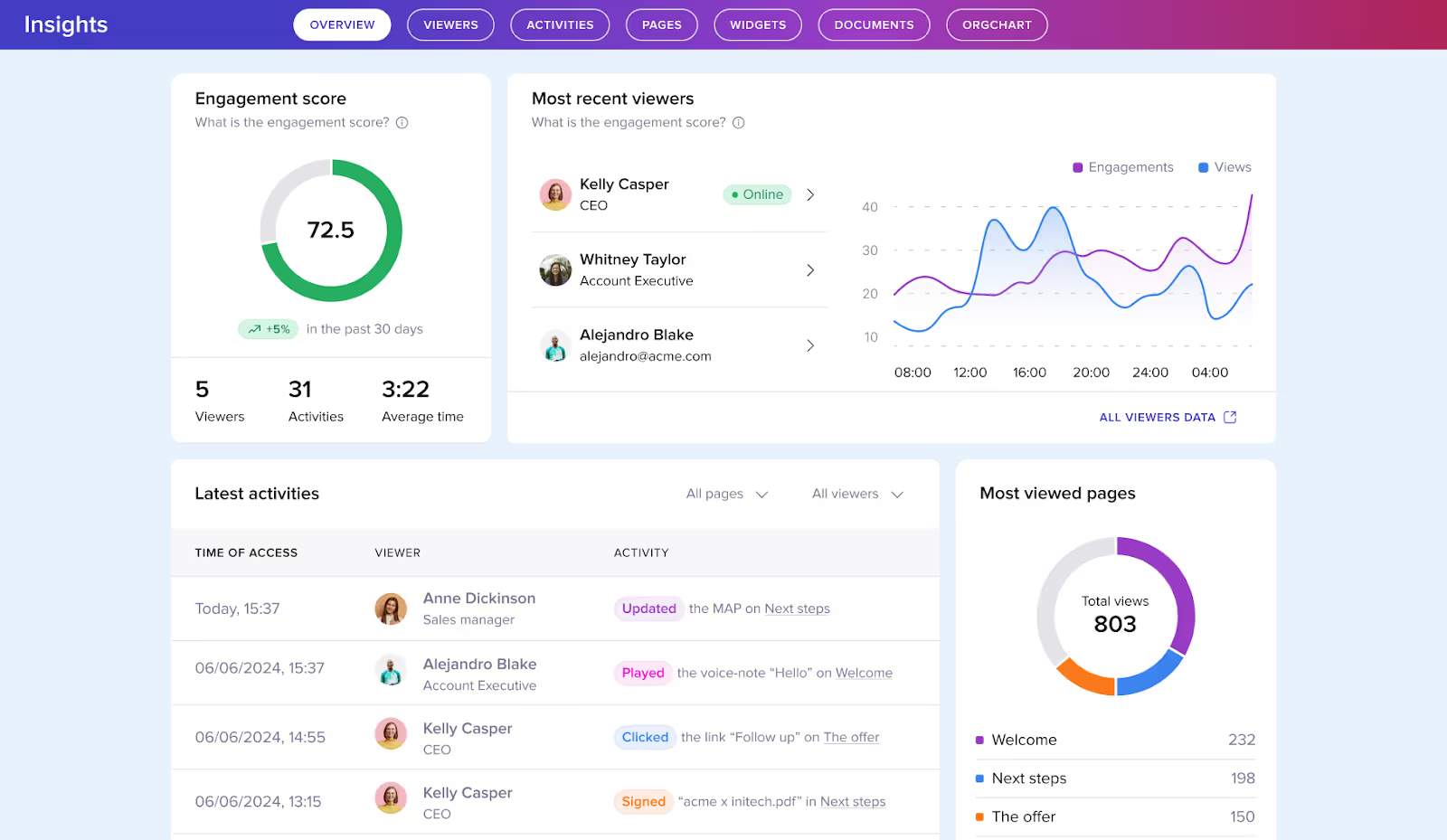
Trumpet helps sales teams manage complex, multi-stakeholder deals by creating interactive, branded spaces, called “pods,” where all sales materials, communication, and collaboration live in one place.
Instead of sending decks, contracts, and resources over scattered email threads and hoping stakeholders keep up, reps can centralize everything in a pod, making it easier to keep momentum and visibility throughout the deal cycle.
For example, after hosting a demo, an Account Executive (AE) could send a Trumpet pod containing recap notes, custom pricing options, onboarding resources, and next steps. As new stakeholders join the deal, like legal or procurement, they can access everything inside the pod without needing another call or sifting through emails.
Key features:
- Custom-branded DSRs ("pods"): Create professional, fully branded spaces that keep all buyer-facing content organized and easily accessible.
- Mutual action plans: Build collaborative timelines and task lists that both the buyer and seller can track.
- Engagement tracking: Monitor who’s viewed which documents, how often, and when, giving reps visibility into buyer intent and activity.
- CRM, calendar, and video integrations: Connect Trumpet pods directly to your CRM, meeting tools, and video platforms for a smooth deal management experience.
- Internal and external commenting: Enable both internal teams and buyers to ask questions, leave feedback, and collaborate asynchronously within the pod itself.
Best for: Sales teams managing complex, multi-threaded deals involving multiple stakeholders, especially in mid-market or enterprise SaaS companies.
💡 If you already have Spekit in your stack, you don’t need Trumpet. With every customer interaction, Spekit automatically creates a digital sales room that centralizes sales materials, like decks, articles, and one-pagers, as well as buying conversations. This eliminates the need for a separate DSR platform like Trumpet.
Notable alternatives:
- Spekit: Digital sales rooms with AI recommendations and AI chat for your prospects to use.
- DealHub: Strong fit for companies looking for DSRs that work with CPQ (configure, price, quote) workflows.
- Dock: Built for creating repeatable buyer journeys with clear templates and collaboration features.
- Aligned: Offers structured, easy-to-use collaboration spaces with a clean, intuitive UI.
Real-life quote: “Why hasn’t this been around until now?! A collaborative and centralized space for our reps and their stakeholders to close deals together, instead of the usual 30+ emails, it’s so much more pleasant for our buyers.” - Malvina El-Sayegh, Director of Revenue Enablement | Oyster
Read: 28 Best Sales Intelligence Software Platforms
Choose your enablement platform by reducing friction in real work
The best platforms don’t add more places to click. They remove friction by meeting reps in motion with the next best step, right where they work. Your bar: a consumer-grade experience that busy reps trust and actually use.
How to find the friction fast
- Shadow real workflows. Sit on calls, scan Slack, watch onboarding. Capture the repeat “when I’m here, I need that” moments. Then turn those into “context signals” like pricing, competitor names, objection language, and next-step phrases you can detect across email, CRM, and call notes.
- Instrument the stack. Audit unused content and low-engagement modules. Low usage is usually high friction. Pair that with context signals so help can appear just-in-time, not just-in-case.
- Map moments that matter. From first outreach to close and handoff, mark the points where reps pause, switch tools, or ask for help. Design for everboarding, not a one-and-done dump.
Translate bottlenecks into buying criteria
Anchor every requirement to the six principles from Just-in-Time: Enablement in a World of AI:
Match problems to capabilities in the flow of work
- “I forget steps mid-task.” Use just-in-time guidance that pops up inside the workflow and nudges at the exact step.
- “Coaching isn’t sticking.” Reinforce with bite-size, contextual nudges after calls and before next steps, not in long courses.
- “Content goes unused.” Deliver the single, most relevant proof point in-app based on role, stage, and buyer context. Think an AI sidekick that whispers “use this case study instead.”
Make it measurable and sustainable
Organizations that adopt just-in-time learning are significantly more likely to exceed seller revenue and customer retention targets. Build your selection around the ability to attribute content and coaching to outcomes, not clicks.
Pro tip from the book: AI needs good fuel. Incentivize CRM and pipeline hygiene so recommendations stay accurate and trusted. Even the smartest model can’t fix dirty data.
You don’t need a bigger stack. You need a system that removes friction and recommends the next right move at the moment of need. That’s how enablement becomes a quiet advantage reps rely on, not noise they ignore.
Next steps
- Learn more about just-in-time enablement here or get a copy of the book by clicking below.
- Learn how to measure sales enablement success here.
